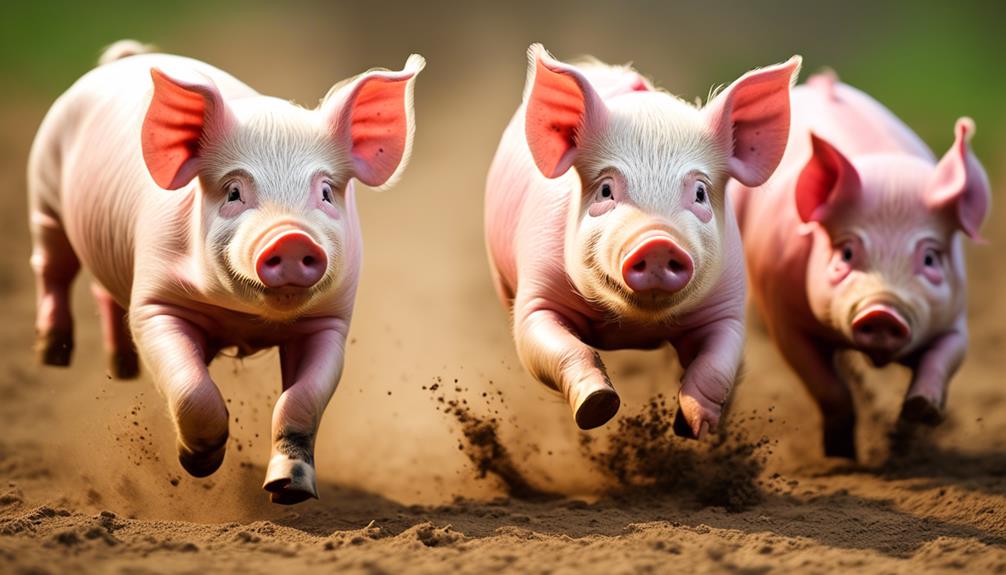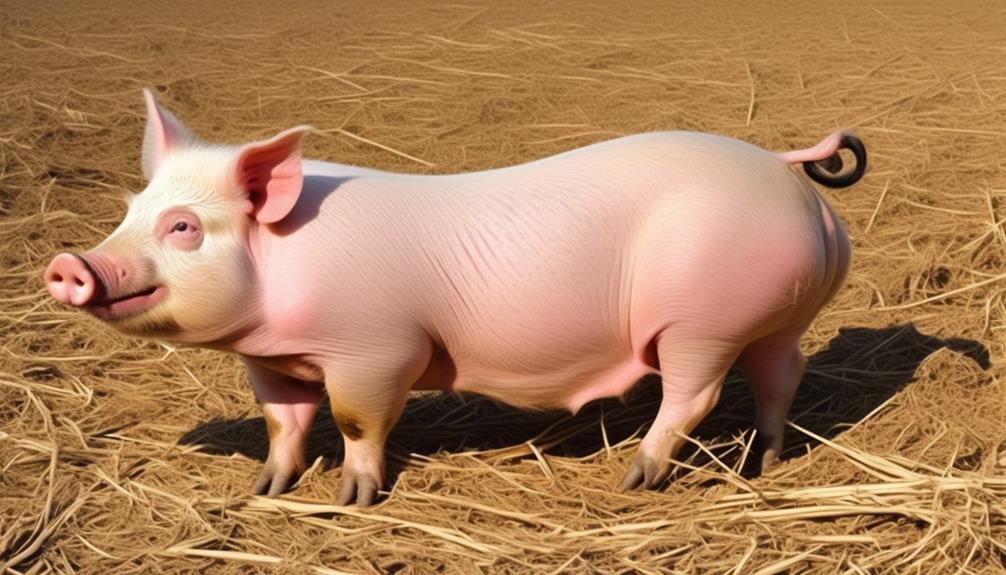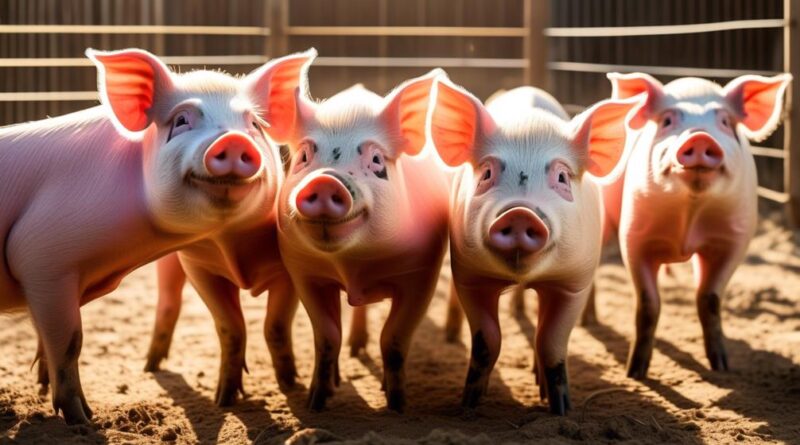Decoding Domestic Pig Behavior Patterns
Did you know that domestic pigs are highly social animals, forming strong bonds with their herdmates and displaying complex communication behaviors? Understanding domestic pig behavior patterns can provide valuable insights into their welfare and help improve their overall care and management.
From social hierarchy and communication methods to feeding behavior and reproductive habits, decoding these patterns can shed light on the intricate world of domestic pigs.
As you explore the various aspects of pig behavior, you'll uncover fascinating insights that can enhance your understanding of these intelligent and fascinating animals.
Social Hierarchy
Understanding the social hierarchy among domestic pigs is crucial for managing their welfare and behavior in group settings. Dominance dynamics play a pivotal role in shaping the social structure of pig groups. In these social hierarchies, pigs establish and maintain their positions through various social interactions. Observing these dynamics can provide valuable insights into the behaviors and needs of individual pigs within a group.
Pigs use a variety of methods to establish dominance within their social groups. This can include aggressive behaviors such as pushing, shoving, or even fighting. However, dominance isn't solely determined by physical strength; vocalizations and body language also play a significant role in these social interactions. Understanding these dynamics allows for better management of pig groups, ensuring that conflicts are minimized and welfare is maintained.
Social interactions among pigs aren't limited to dominance displays. Affiliative behaviors, such as grooming and social bonding, also contribute to the overall social dynamic. These interactions can help alleviate tension within the group and promote a sense of community. Recognizing and encouraging positive social interactions can enhance the overall well-being of the pigs within the group.
Communication Methods
Pigs communicate through a variety of vocalizations and body language to convey information and maintain social dynamics within their groups. Vocalization signals play a crucial role in pig communication. They use different types of vocalizations such as grunts, squeals, and snorts to express emotions and convey specific messages. For example, a mother pig might use a low, rhythmic grunt to calm her piglets, while a high-pitched squeal could indicate distress or discomfort. Pigs also use vocalizations during feeding time to establish food hierarchy within the group.
In addition to vocalizations, pigs rely heavily on body language cues to communicate. They use physical gestures and postures to convey dominance, submission, aggression, or playfulness. For instance, a dominant pig might puff out its chest, raise its head, and push its weight around to assert dominance, while a submissive pig may lower its head and avoid direct eye contact. Understanding these body language cues is essential for maintaining harmony within the group and avoiding conflicts.
Feeding Behavior
During feeding, pigs exhibit a range of behaviors that reflect their social dynamics and hierarchy within the group. Understanding these behaviors can provide insight into the complex social structures and interactions within a pig herd.
Here are some key points about feeding behavior in pigs:
- Feeding Preferences: Pigs have individual preferences when it comes to food. Just like humans, some pigs may prefer certain types of food over others. They may show excitement or enthusiasm when offered their favorite treats, while being more indifferent towards other food items. Observing their feeding preferences can give valuable information about their dietary needs and tastes.
- Foraging Techniques: Pigs are natural foragers and have developed various techniques for finding and consuming food. They use their snouts to root around in the soil, searching for roots, insects, and other edible items. This instinctual behavior is important to consider when designing feeding environments for pigs, as it allows them to engage in natural foraging activities.
- Mealtime Interactions and Feeding Competition: When feeding in a group, pigs establish a hierarchy that determines access to food. Dominant pigs may push others away from the food source, while submissive pigs may wait for their turn. This feeding competition can impact the overall well-being of the group and is an important aspect to consider when managing pig feeding environments.
Understanding these feeding behaviors is crucial for providing appropriate care and ensuring the welfare of domestic pigs.
Nesting and Resting
Feeding preferences and social dynamics impact the nesting and resting behaviors of domestic pigs within a herd. Understanding nesting habits and resting preferences is crucial for maintaining the welfare and productivity of these animals.
Pigs have a natural instinct to nest, especially before giving birth. They'll gather straw, hay, or other bedding materials to create a comfortable and secluded nest. Providing suitable nesting materials is essential to ensure the sow's comfort and the safety of her piglets. Additionally, the availability of nesting areas can influence the social dynamics within a group of pigs, as dominant sows may claim nesting spots, leading to potential conflicts.
When it comes to resting preferences, domestic pigs exhibit a strong inclination for lying down and resting. They prefer to rest in dry, comfortable areas, especially after feeding or engaging in social interactions. Providing adequate resting spaces with appropriate bedding materials is essential to promote good welfare and prevent injuries. Pigs are also known to engage in social resting behaviors, often lying close to each other for warmth and companionship. Understanding their resting preferences is important for creating suitable housing environments that promote relaxation and reduce stress.
Play and Exploration

Engaging in play and exploration, domestic pigs demonstrate curiosity and agility as they interact with their environment, fostering cognitive development and physical coordination. Play behavior is a vital component of a pig's life, serving as a form of social interaction, mental stimulation, and physical exercise. This activity allows pigs to learn about their surroundings, develop problem-solving skills, and build confidence in their movements. Their exploration tendencies are driven by a natural inclination to investigate new sights, smells, and textures, helping them adapt to their environment and understand their place within it.
- Social Interaction: Pigs engage in play with their penmates, displaying behaviors such as chasing, wrestling, and playful vocalizations. These interactions are essential for developing social bonds and communication skills within the group.
- *Mental Stimulation*: Through play, pigs enhance their cognitive abilities by testing boundaries, solving simple challenges, and learning from the outcomes of their actions.
- *Physical Exercise*: Playtime provides an outlet for physical energy, promoting muscle development, coordination, and cardiovascular health in pigs.
Aggression and Dominance
When observing domestic pig behavior, it becomes evident that aggression and dominance play significant roles in their social interactions. Aggression triggers in pigs can include resource competition, establishing social hierarchy, or protecting territory. Pigs may display aggressive behaviors such as charging, biting, or vocalizing to assert dominance or defend their position within the group. Understanding the dynamics of aggression and dominance in pigs is crucial for effective management and welfare.
Dominance displays are common among domestic pigs and are often demonstrated through body language and vocalizations. Pigs may use assertive postures, such as standing tall with bristled fur, to convey dominance. They may also vocalize loudly or use physical force to establish their authority within the group. It's important to recognize these displays as natural behaviors rather than as signs of inherent aggression.
Addressing aggression and dominance in domestic pigs requires careful observation and proactive management strategies. Providing ample space, resources, and enrichment can help minimize aggression triggers and reduce conflicts within the group. Additionally, understanding the social structure of the pig herd and allowing for natural hierarchy establishment can contribute to a harmonious living environment.
Reproductive Behavior

The reproductive behavior of domestic pigs is influenced by various factors, including social dynamics and environmental cues. When it comes to courtship rituals and mating preferences, pigs demonstrate interesting behaviors that are worth exploring.
- Courtship Rituals
- Pigs engage in courtship rituals that involve behaviors such as nudging, chasing, and vocalizations. These rituals are essential for establishing social bonds and determining mating readiness.
- Female pigs may display receptive behaviors during courtship, such as presenting themselves to the male and responding to his advances. This communication is crucial for successful mating.
- Mating Preferences
- Pigs exhibit mating preferences, often choosing specific partners based on social hierarchy, scent cues, and previous interactions. These preferences can impact the dynamics within the group and influence breeding success.
- The presence of a dominant male can influence mating preferences within the group, as females may show a preference for mating with the dominant male due to his perceived genetic fitness and social status.
- Environmental Cues
- Environmental factors, such as the availability of resources and the presence of other animals, can influence reproductive behavior in domestic pigs. These cues can affect the timing of mating, the intensity of courtship rituals, and the overall success of breeding efforts.
Understanding the intricacies of courtship rituals and mating preferences in domestic pigs provides valuable insights into their social dynamics and reproductive strategies. By considering these factors, pig farmers and animal behavior researchers can better support the natural reproductive behaviors of pigs in various husbandry settings.
Environmental Adaptation
Adapting to their environment, domestic pigs demonstrate remarkable resilience and resourcefulness in response to varying conditions. When it comes to temperature regulation, pigs have a preference for cooler environments, as they're prone to heat stress. They rely on wallowing in mud or seeking shade to cool off. In cold weather, they huddle together for warmth, displaying social behaviors that help them maintain body heat. Pigs also show distinct shelter preferences, seeking out comfortable bedding and protection from harsh weather conditions.
Foraging strategies play a crucial role in a pig's environmental adaptation. Their omnivorous nature allows them to adjust their diet based on food availability. When natural forage is limited, they can efficiently consume a variety of agricultural by-products and food scraps, showcasing their adaptability to changing food sources. In the wild, pigs use their keen sense of smell to locate roots, insects, and small animals for sustenance. This natural foraging behavior persists in domestic pigs, enabling them to thrive in diverse environments.
Frequently Asked Questions
How Do Domestic Pigs Interact With Other Animals on the Farm?
On the farm, domestic pigs interact with other animals in various ways. They establish social hierarchy dynamics within the livestock community, displaying complex behavior patterns. Understanding their interactions with other animals can help in managing farm dynamics effectively.
What Are Some Common Behavioral Differences Between Male and Female Domestic Pigs?
When it comes to male and female domestic pigs, there are behavioral differences to consider. Males tend to display more aggression and dominance behavior, while females may exhibit different social hierarchy and feeding patterns.
Do Domestic Pigs Exhibit Any Unique Behaviors When They Are in Pain or Distress?
When domestic pigs are in pain or distress, they exhibit unique behaviors. They may vocalize as a pain response and show distress through their body language. Understanding these signs is crucial for providing proper care and intervention.
How Do Domestic Pig Behavior Patterns Differ in Various Climates and Environmental Conditions?
In various climates and environmental conditions, domestic pig behavior patterns differ. Feeding habits and group dynamics adapt, while vocalizations reflect environmental changes. Pigs exhibit remarkable environmental adaptation, showcasing the influence of climate and surroundings on their behavior.
Are There Any Specific Behaviors That Domestic Pigs Exhibit When They Are Feeling Stressed or Anxious?
When pigs feel stressed or anxious, they may display specific behaviors like increased aggression, restlessness, or excessive vocalization. Providing environmental enrichment and addressing social dynamics can help reduce stress and maintain a balanced group hierarchy.
Conclusion
So, now you have a better understanding of domestic pig behavior patterns.
From their social hierarchy and communication methods to their feeding behavior and reproductive behavior, pigs exhibit a wide range of behaviors that can be fascinating to observe.
Understanding these patterns can help improve their welfare and the way we interact with them.
Keep observing and learning about these amazing animals!
